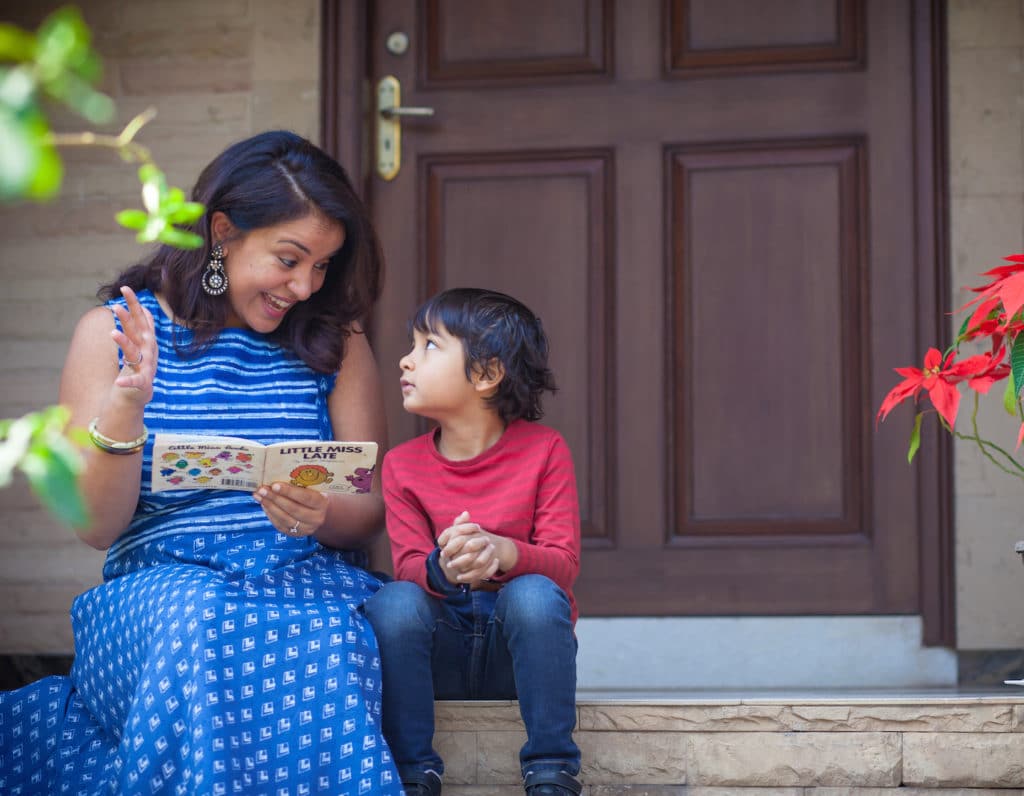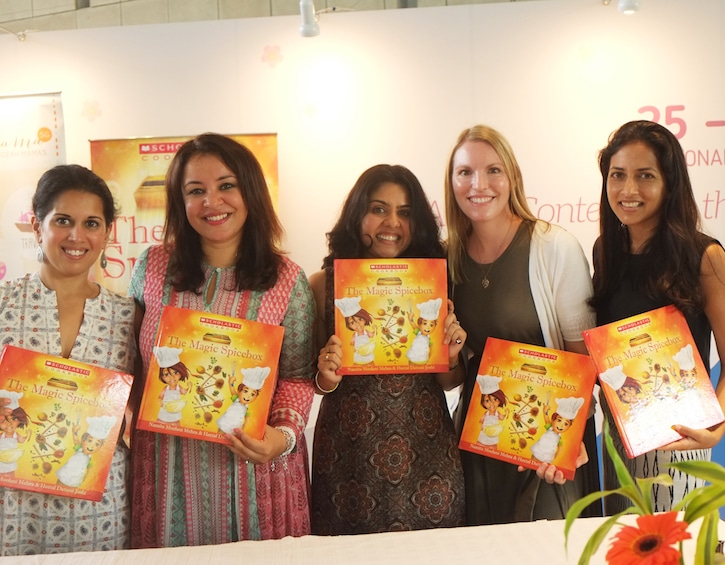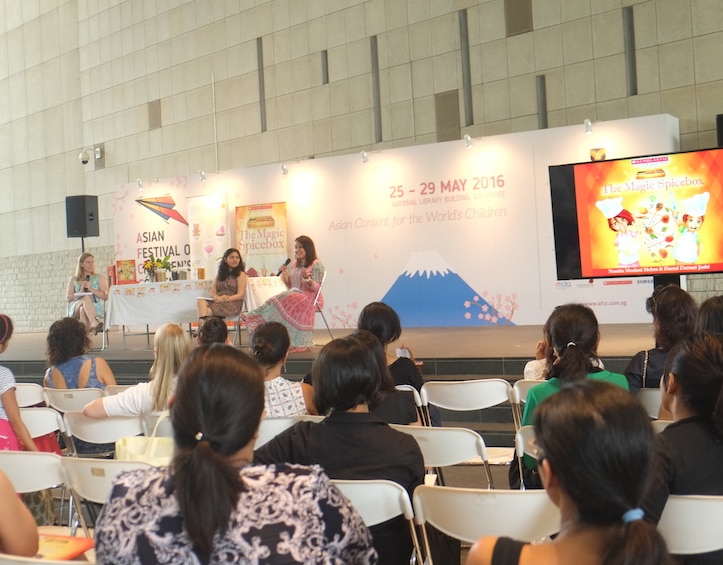
Do you spin magical yarns at bedtime that have you wondering, Should I write a children’s book? Singapore mama and children’s author Namita explains how to make it happen!
Namita Moolani Mehra is a longtime Sassy Mama contributor, and we’ve been thrilled to follow her success in both the food (Indian Spicebox) and literary worlds (her first children’s book, The Magic Spicebox, came out in 2016). Her next children’s book, Superfoods for Superheroes, will be published by Harper Collins later this year (and was in fact inspired by an article she wrote for us a few years back!). Namita is obviously insanely talented, but, as she explains below, it takes a lot of planning, research, drafting and networking to make literary dreams come true. If you’re at all interested in writing a children’s book of your own, check out Namita’s 5-step guide below!

It’s bedtime. You’re too tired to grab a book from the bookshelf, and besides you’ve read them all a million times and it’s too dark in the room anyway. So, you start to tell your little one a made-up story. As you say goodnight and walk out, you marvel at your story and wonder… should you write a book? Guess what? MANY parents harbor a secret dream of becoming an author and writing a children’s book!
And I’m here to help you realize your dream…or at least get started in the right direction. I don’t want to scare you, but I do want you to know that it is a fairly complex, highly-involved and challenging process. It requires a great deal of commitment to break into the children’s book-writing world, and unless you end up becoming the next Mo Willems, hang on to that day job for the time being, ok?
Step 1: Do your homework. Be a sponge.
Understand the basics. There are picture books, middle-grade chapter books, books for young adults (YA), novelty books, fiction, non-fiction and many more formats to consider. Once you have a sense of what kind of book you want to write (or have written), then really dig deep.
What are the rules? For example, picture books are typically 500 words or less, within a format of 32 pages. There are great books and online resources that will really break it down for you. For example, in the picture book world, there is a great book by Ann Whitford Paul called Writing Picture Books that is truly enlightening and a must-have for any picture-book writer.
There are online groups like KidLit411 and 12×12 that are dedicated to the art of picture book writing. There is an incredible amount of detail and strategy that goes into creating a book. Learn about character arcs, plots, endings, whether to rhyme or not to rhyme, writing drafts and revising them, critique groups/partners, illustrators and art notes, making a dummy book, how to pitch to a publisher and what to do once you have a book deal.
I will be launching my second children’s book later this year and I am still learning a ton every day! I spend at least an hour a day just learning – I read articles and books, I watch webinars by famous picture book writers, I read the Facebook group discussions, and listen to podcasts (“The Children’s Book Podcast” and “Literaticast” are two I recommend). There is a TON of information out there and a LOT to learn.

Step 2: Join a group. Attend events.
There are a number of professional organizations both online and offline, dedicated to the art and science of children’s book writing. These groups provide great support, manuscript critique partners, great resources and access to relevant events. I am a member of SCBWI—Society of Children’s Book Writers & Illustrators. The Singapore SCBWI chapter has been my rock and life-saver these last few years by providing me valuable support, endless encouragement and an incredible amount of knowledge. I attend a weekly SCWBI member picture book critique meeting where everyone brings their manuscript and reads it out loud, followed by a critique session around the table. I was terrified of sharing my work at first, but the tone of the meeting is very positive and the participants are warm and encouraging. The feedback process is very helpful and really critical to the process.
It is incredible to be surrounded by talented authors and illustrators, both experienced and aspiring, and watch the journey from manuscript, to multiple drafts and revisions, to a real book! If you would like more information about SCBWI Singapore chapter ($80 USD for annual membership) you can email regional chapter head David Liew at [email protected].There are a number of different events and conferences each year globally as well. In Singapore, a prominent event is AFCC (Asian Festival of Children’s Content) held annually at the National Library. This conference is a great opportunity to meet authors, illustrators, editors and attend some amazing talks, presentations and even masterclasses.
Step 3: Write, revise and write some more!
Get your story down. Don’t worry about perfecting it just yet. Most first drafts are usually pretty far from where your final story is going to end up. Read, revise, critique, re-write. Find a critique partner or group to give you objective feedback.
Keep an eye on your word count, keep your story tight and for a picture book go ahead and create a dummy book so that you can understand how the story will flow, make sure that the page turns be compelling, check if it is all fitting in nicely into the given number of spreads (picture books typically have 12-14 spreads. This article has more good insights).

Step 4: Where does an illustrator come in?
Usually, the editor at the publishing house finds an illustrator and will handle this process completely. There are a few exceptions to this if a) a writer is also an illustrator b) you are working with a close partner/friend/relative from the beginning and that person is also an illustrator/designer. Finding an illustrator is typically not a step for a writer. For my second book, I pitched with some sample illustrations by a freelance illustrator based in Bali. It turns out the editor really liked her work so they are illustrating my book now.
Step 5: Make Your Pitch
Once you have a final manuscript, you are ready to pitch your work! This is the REALLY tough bit. (I’m making an assumption that you want to be published and not self-publish. Self-publishing is fine if you are ready to do all the marketing, sales and distribution yourself, but it’s a whole different topic we will save for another day.)
If you want to pitch your manuscript to publishers in the US or UK, you will need an agent. How do you find an agent? You send query emails to agents accepting manuscripts. These folks are pretty active on Twitter and you can also go to all the big publishing house websites to see what editors are looking for. There are lists of agents online plus tons of resources on writing query letters.
I think this is a process every writer has to go through themselves depending on what they are pitching/genre etc. Here are a few helpful places to get started, though:
www.writersdigest.com/publishing-insights/picture-book-literary-agents-open-to-submissions
www.thejohnfox.com/2020/01/top-20-childrens-book-agents-in-2020
www.tckpublishing.com/childrens-book-literary-agents
There are also pitch events on Twitter and pitching opportunities at conferences. Having a really compelling short pitch for your story is essential!

In Asia, having an agent is not necessary and you can query or pitch to editors directly (online or at events). Check out the major publishing house websites (Scholastic Asia, Epigram, Penguin SEA, Marshall Cavendish). For example, this post from Epigram Books has all the details you need to understand the submission process. Submission guidelines and process varies by publisher, but is also fairly standardized. Make sure you read the requirements on formatting etc. carefully to avoid landing up in the dreaded slush pile!
As a parent, you are perfectly positioned to be a great children’s book writer as you are probably reading a ton of amazing books to your children. Your head is full of ideas, funny things your kid said, silly stories from school, meaningful moments…. inspiration is all around you, all day, every day! If you’ve decided to give it a go, then write down your ideas, anytime inspiration strikes. Try to develop a daily writing habit and dedicated time to learning about the art of writing for children.
Good luck and may all your writing dreams come true!
Read more:
How this Mama of Two Wrote a YA Novel in Her ‘Spare’ Time
Meet Singaporean Author Rachel Heng, Author of International Smash ‘Suicide Club’






 View All
View All





 View All
View All









 View All
View All





![[𝗦𝗔𝗩𝗘 𝗧𝗛𝗜𝗦] 𝗞𝗶𝗱-𝗔𝗽𝗽𝗿𝗼𝘃𝗲𝗱 𝗗𝗲𝘀𝘀𝗲𝗿𝘁 𝗦𝗽𝗼𝘁𝘀 𝗬𝗼𝘂 𝗖𝗮𝗻 ‘𝗘𝗮𝘁 𝗳𝗼𝗿 𝗙𝗿𝗲𝗲’ 𝗪𝗶𝘁𝗵 𝗖𝗗𝗖 𝗩𝗼𝘂𝗰𝗵𝗲𝗿𝘀! 🍦🍩🧁😉
Before you ask “Can use CDC voucher?” Yes, you definitely can! These spots are perfect for an after-school treat, weekend fun, or just saying “yes” to dessert without saying goodbye to your wallet.
Comment “Sweet” or tap the link in bio for more foodie recommendations!
Got a fave kid-friendly spot that accepts CDC vouchers? Let us know in the comments too!
.
.
.
.
.
.
.
#CDCVouchersSG #SGMumLife #KidFriendlySG #FreeDessert #HeartlandEats #SweetTreatsSG #SGParents #FamilyFunSG #WafflesAndIceCream #BudgetParenting #ThingsToDoWithKidsSG #SGCafes #SupportLocalSG #KidsEatHappy #CDCAdventures](https://www.sassymamasg.com/wp-content/plugins/instagram-feed/img/placeholder.png)
